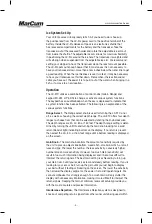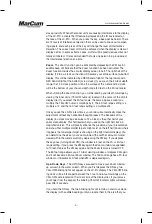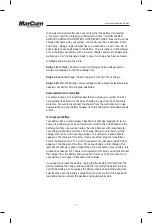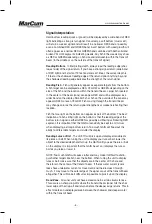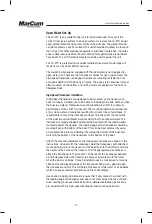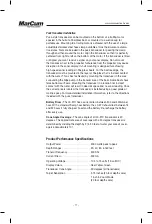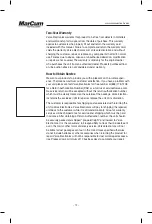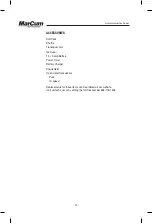
www.marcumtech.com
- 4 -
Ice System Set-Up
Your LX-3tc comes virtually ready to fish. All you need to do is hook up
the positive lead from the LX-3tc power cord to the positive terminal of the
battery. Inside the LX-3tc deluxe soft pack is an electronics shuttle that
has recessed compartments for the battery and the transducer. Take the
transducer out of the recessed holder and rotate the adjustable ice arm out
from inside the shuttle. The adjustable ice arm allows for maximum flexibility
in positioning the LX-3tc around the ice hole. The transducer is weighted and
will self-align when suspended from the adjustable ice arm. We recommend
setting your stopper to have the transducer down the least amount possible.
The LX-3tc puts out enough power that in most cases it is not necessary to
have your transducer down more than a few inches below the water line to get
a good reading. When the ice thickness is over two feet, it may be necessary
to have your transducer set farther down. Remember--the less transducer
cable you have out, the easier it is to pull it out of the water when bringing in a
fish, or to move to a new location.
Operation
The LX-3TC utilizes a combination of control knobs (Gain & Range) and
keypad (IR, ZM, UP & DN) to change or activate various system functions.
The keypad has an audible beep when the key is depressed to indicate that
a system function has been activated. The following is an explanation of the
various system functions.
Range Select - The Range select knob is used for turning the LX-3TC on or
off, as well as choosing the correct depth range. The LX-3TC offers four depth
ranges to choose from that can be selected by rotating the knob clockwise.
The depth ranges are 20, 40, 80, or 160 feet. The depth-range setting is deter-
mined by turning the unit ON and turning the Gain knob looking for a solid
return (band of light) indicating bottom on the display. If no return is present,
then select the 40-, 80-, or 160-foot range until a bottom reading is displayed
on the screen.
Gain Knob - The Gain knob controls the amount of sensitivity required by
the unit to pick up objects like bottom, weeds, fish, smaller bait-fish, or small
lures and jigs. The lower the number, the less sensitivity, conversely higher
numbers mean more sensitivity. However, too much Gain (sensitivity) will
result in too much information being displayed, and it becomes difficult to
interpret the return signals. The best Gain setting is achieved by turning up
your Gain from 0 until you receive a clear and steady bottom reading. If you’re
looking for your lure or bait, turn up the gain until you just begin to display
your bait without it fading or flickering on the screen. The lower the sensitivity,
the narrower the display segments, the easier it is to distinguish targets. We
cannot emphasize this strongly enough. Too much Gain will only clutter the
display with unnecessary information, making it more difficult to interpret the
return signals. Keeping the Gain at minimum levels will actually provide you
with the most accurate and precise information.
Interference Rejection - The Interference Rejection system is designed to
knock out competing return signals from other sonar units being used within




